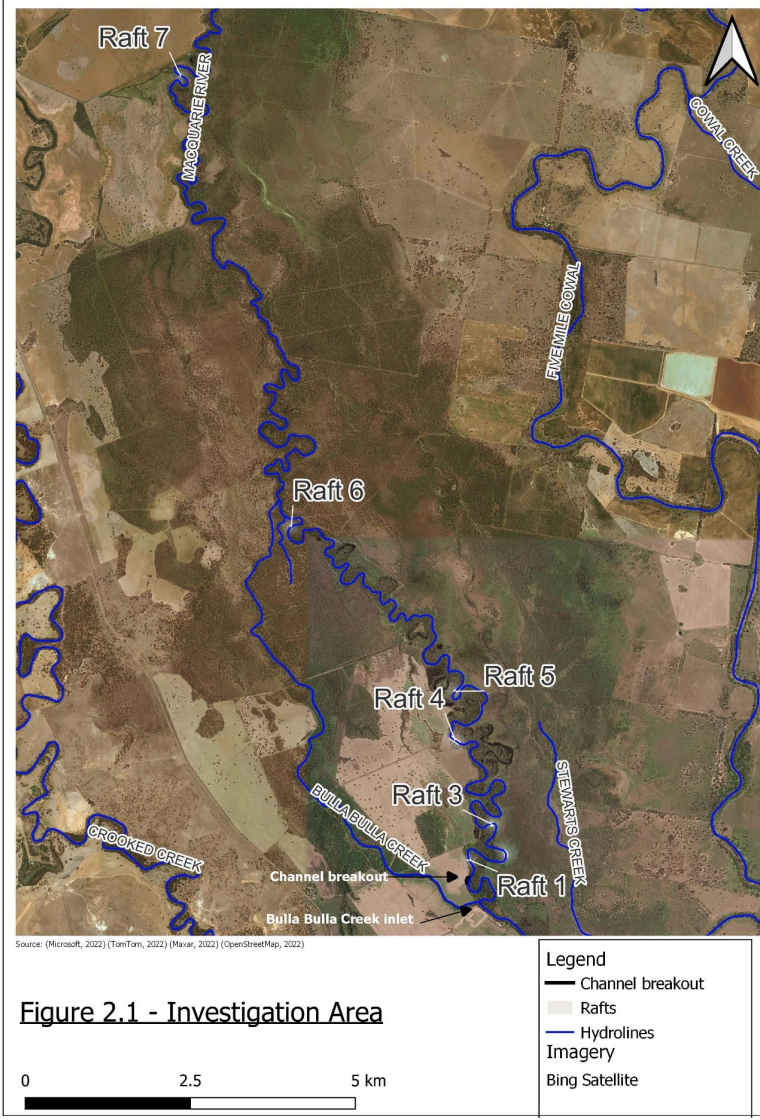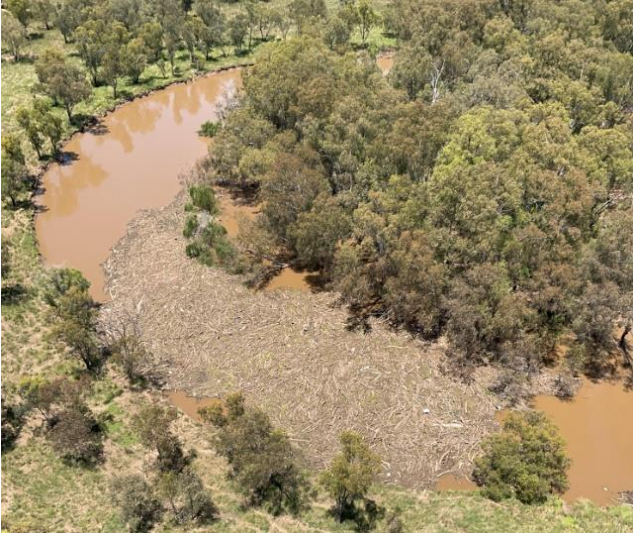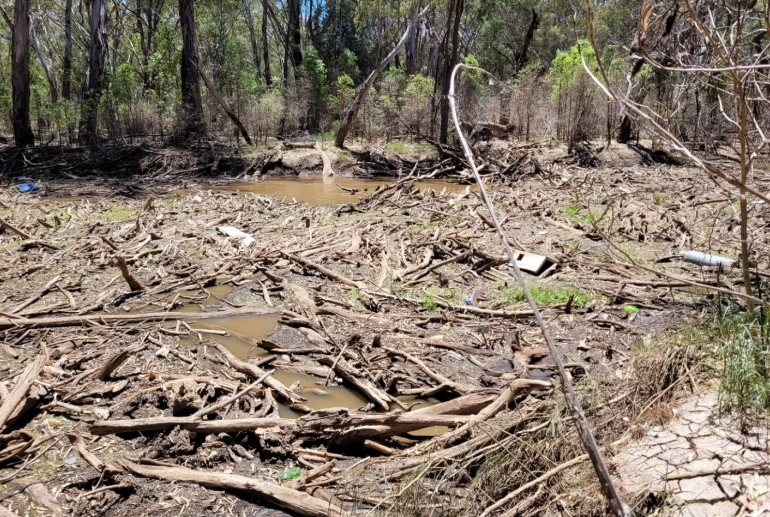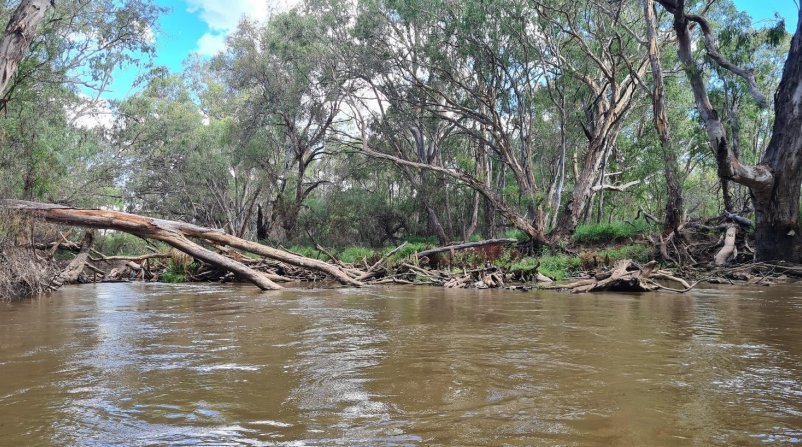Removal planned as unwanted 'rafts' clog Macquarie River
Kristin Murdock
19 June 2023, 9:20 PM
 Raft 1 looking downstream in December 2022. SOURCE: NSW EPA (Ozfish)
Raft 1 looking downstream in December 2022. SOURCE: NSW EPA (Ozfish)The unprecedented flooding of the last few years brought many issues for the Western Plains, many of which are ongoing.
Among them is the formation of several large "rafts" of debris which has collected in the Macquarie River downstream of Warren, threatening to impact river flow and cause erosion.
Made up of woody materials (both native and exotic) and man-made items such as chemical drums, tyres and plastics.
Numerous large debris rafts have been identified in the Macquarie River reach between Warren and Marebone Weir, and landholders and authorities have come together to plan their removal.
Some of the rafts are known to be mobile and are slowly moving and changing form. However, at least one raft appears to be fixed, in that it hasn’t moved during the recent 2022 flood events.
The NSW Environmental Protection Authority (EPA) held a community drop-in session was held in Warren in February with other agencies including Local Land Services (LLS), Department of Planning and Environment, Environment and Heritage Group (EHG) and EMM Consulting.
These rafts are referred to by relevant authorities as Rafts one to seven (from upstream to downstream). Raft one is located approximately 26 kilometres downstream of Warren and Raft seven is located approximately the same distance upstream of Marebone Weir.

The location of debris rafts on the Macquarie River near Warren (Image NSW EPA)
Last week the EPA announced that the partial removal of rafts four and seven will begin in August
"We would like to thank all the community members who attended the community drop-in session held in February 2023 with representatives from the NSW Environmental Services Functional Area," a spokesperson from the NSW EPA said.
"The session provided valuable feedback on community concerns and the potential risks associated with rafts. Monitoring will be undertaken before and after the partial removal of the rafts and include water levels, flow, and water quality, this will also be extended across the length of the Macquarie River."

An aerial image of Raft 2 taken on 4 December 2022. SOURCE: NSW EPA (Ozfish)
Another Community Drop-in Session is planned for concerned residents and those wanting more information.
Raft removal not a simple matter
In addition to community feedback, considerations for removal include: whether the rafts are anchored or floating; the nature of the debris in the rafts: manmade, hazardous, exotic woody debris, native woody debris; and impacts on water flow, fish passage and bank erosion.
A monitoring program covering erosion potential, water levels and flow and water quality along the length of the Macquarie River where rafts one, two, three, five and six are present will also be implemented.
Based on their understanding of fish behaviour in the Murray Darling Basin, DPI Fisheries advises that it is unlikely that the rafts, including the anchored rafts, are acting as a barrier to fish passage or impacting fish navigation due to decreased light conditions.

The upstream portion of Raft 4, 19 December 2022. SOURCE: NSW EPA (Ozfish)
DPI Fisheries will be undertaking native fish movement research along the Macquarie River over the coming months in association with the Commonwealth Environmental Water Office related to water for the environment, which may provide an opportunity to assess fish movement related to the rafts.
Bron Powell, the project manager of the Central Murray Darling Basin branch of fishing conservation charity OzFish, said willow logs are creating many of the blockages.
Ms Powell told ABC reporters that the longest raft is about 130-metres long and that the seven rafts go almost all the way across the river, though water can still flow underneath.
"So many plastic bottles, chemical drums, fridges, tyres - it's a big mess," she said. "Fish don't really like swimming up dark passageways, it spooks them out."
DPI Fisheries advises that native woody debris plays an important role in rivers for fish habitat and productivity and should be retained where possible.
The partial removal of rafts four and seven will also allow for stockpiling of large native woody snags for possible reintroduction into the river system.
BELOW: Raft 7 looking upstream (4 January 2023) IMAGE SOURCE: NSW EPA (Ozfish)





